Grassroots Spotlight: Native Health in Native Hands
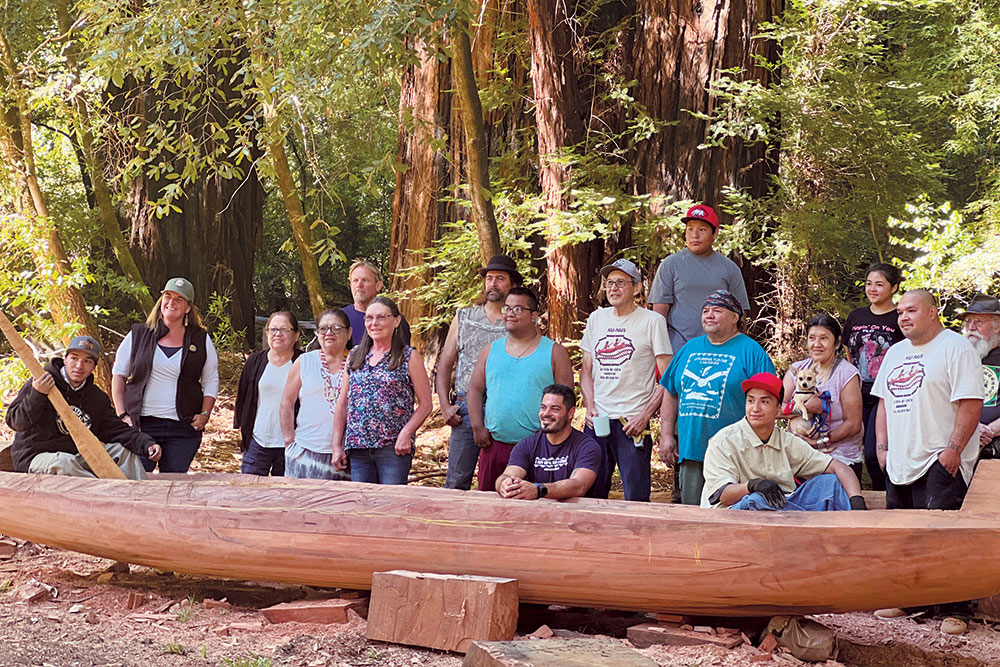
Revitalizing Wailaki Cultural Practices
By Kerry Reynolds, Organizational Development & Partner Support, Trees Foundation
In late 2021, an email came into Trees Foundation that asked about our mapmaking services. That was nothing unusual—GIS mapmaking is one of our most popular services. Little did I know then, that we had just made contact with Perry Lincoln, a versatile change agent who has been the quiet catalyst for events that are revitalizing Wailaki culture in Southern Humboldt. Through his organization, Native Health in Native Hands, he is empowering Natives and non-Natives alike to engage in ancient ways of connecting to and caring for the land.
Unexpectedly, Perry would be there to save me a few months later, when I found myself unprepared and in need of a radio guest. Trees Foundation recently became host of the 5th Tuesday Environment Show on KMUD Community Radio, and I had forgotten to mark my calendar. When I got a reminder just a few hours before show time, I called Perry and he immediately agreed to be my featured guest.
Below you can read a partial transcript of that radio interview, followed by transcripts describing two other groundbreaking events that Native Health in Native Hands put into motion—a prescribed fire training for Indigenous youth that prepared them to join the crew of the Southern Humboldt Prescribed Burn Association, and a historic collaboration to build and return Indigenous redwood canoes to the
Eel River.
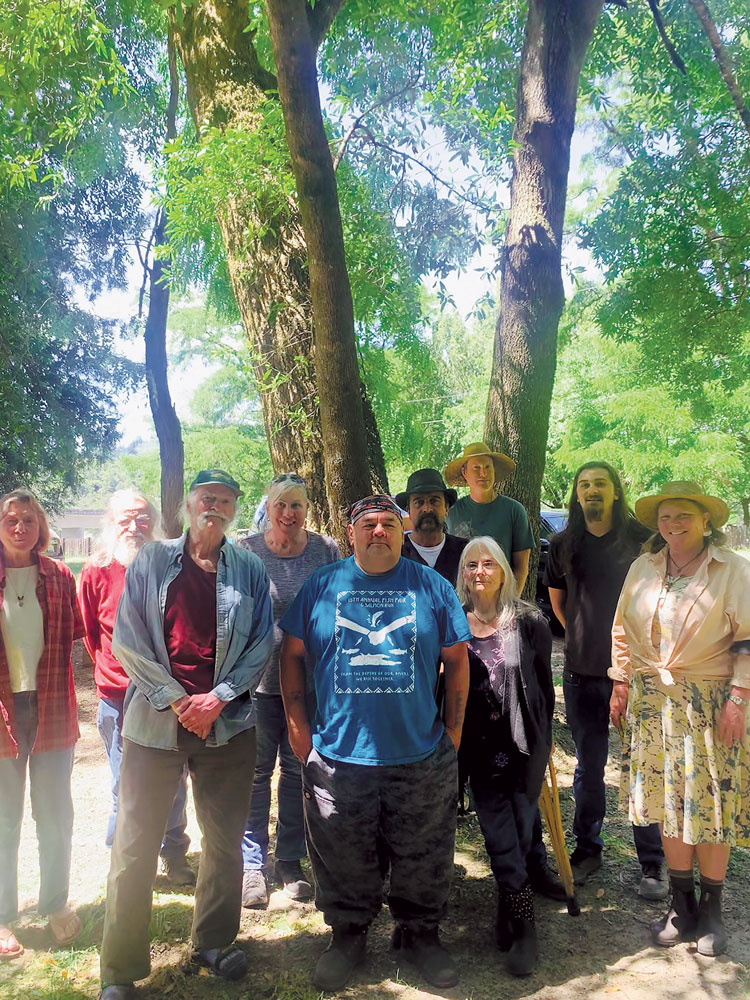
Perry Lincoln Describes Ancient Skills Workshop offered by Native Health in Native Hands
This is a partial transcript of a live interview on The Environment Show, KMUD Community Radio, on May 31, 2022.
Perry Lincoln: My name is Perry Lincoln, and I’m a member of the Round Valley Indian Tribes down in Covelo, California. But my ancestral homelands are in the Wailaki areas of Garberville, Alderpoint, Hettenshaw Valley, and the Mattole River. All through those areas are my ancestral homelands. And so I have a group called Native Health in Native Hands, and basically, our focus is cultural revitalization, traditional land-use practices, and modern land-use practices [as they relate to] restoration. Right now, we’re working on language, plant identification, and we are collaborating with Six Rivers National Forest, California State Parks, and private landowners. RFFI [Redwood Forest Foundation, Inc.] is one of the private landowners that we’re working with. Eel River Canyon Preserve is also a new collaborator. They just bought some land over on the main stem of the Eel River, south of Alderpoint.
We’re trying to get the Eel River Sovereign Wailaki group going again. They were active a few years ago, and we’re hoping to get them active again in some restoration projects. We have some youth that are going to come and do some basket-weaving demonstration, and we’re going to talk about the plants that are in the area and how we can preserve and restore some of the plants, like dog-bane.
Everyone is welcome to come [to the workshop that was in June], and maybe even share knowledge. We really feel that it’s important for the native knowledge that we have to be shared. People ask all the time, “Well, what did the native people do in the forest?” And we want to share that so that everybody has a really good idea of how can we work together to make a healthier forest, and understand some of the things that have helped the forest to not be so healthy. Now we have these devastating fires every year, and we need to bring more awareness about why those things are and what we can do as a community—not just one group here and one group there—but as a community. How can we address these issues that are right at our back door? I have relatives over in Hettenshaw Valley and other areas that really were devastated with that August [Complex] fire. They had to do everything they could to save their homes, and with people working together, they did it. A lot of people lost a lot. But working together and having the knowledge is the most important thing.
Kerry Reynolds: It’s so true. Southern Humboldt is definitely categorized as a high-risk, high-hazard area for fire, and bringing back cultural fire and trying to bring back more of the Wailaki culture is so important right now. It’s really exciting, the work that you’re doing. Your ancestors are from the Alderpoint area?
Lincoln: Yeah, Dobbyn’s Creek, Alderpoint, and Hettenshaw Valley, all the way over to South Fork. South Fork Mountains is my ancestral homeland. My grandmother came from Dobbyn’s Creek, and then we have ancestry down on Kikawaka and further south on the main stem of the Eel River down to the North Fork of the Eel River. Native people lived all along the rivers and along where there was water. We lived along the rivers everywhere there was a flat area that we could have a village site at, and in the summertime, we went to the mountains.
Reynolds: We’re using names that were created in the last 150 years by settlers. I know that restoring and supporting the cultural return of the Wailaki language is also a passion of yours.
Lincoln: We’ve been working on the language for about 10 years. Ben Schill, he’s really been working in that area on language, and we have a linguist at Cal Poly Humboldt now that’s a Hupa speaker and also helping us revive the language. She’s worked with the school in Round Valley, so I think it’s been about three years now that we’ve had language classes for the first time in Round Valley at the high school and the grammar school. Then we have a linguist from Davis, who’s also helped with our language revival…so people have been working on it diligently.
Reynolds: And are you familiar with any cultural fire practices?
Lincoln: Yeah, I’m familiar. We burned in the fall, and we burned sometimes in the spring, when there was a really wet spring, for basket materials that made the material stronger and it helped for bugs and it help for invasives and other plants. It just made the ground a lot more healthy—we needed that fire. Since we haven’t had fire, there’s a lot of brush that is fuel when there is a fire. Basically we were burning around village sites so that if there was a major fire, it wouldn’t just come raging through our village sites. But it also helped the plants that we use as food, like our bulbs, it helped them to grow better too. All of this is documented. There’s a lot of written material nowadays on how fire does help plants in their resiliency.
Reynolds: Great, so we did have a caller who did not want to go on the air, but they wanted to mention the Condor Project and ask if you were a part of that now. I’ve been watching it, and it’s really exciting. It’s a project of the Yurok tribe to reintroduce condors.
Lincoln: We weren’t able to go when they released the condors, but we have some pictures. It’s a great undertaking for that tribe…We’re hoping that one day we can have condors down in our area. It takes the support of people, like I said before, it won’t be just native people, it would be people willing to take care of and have a place in the mountains that they could have a housing [habitat] area. And I think at some point, we’re going to try to have condors. I don’t want to say just on the Eel River, because there’s so many waterways in that area, I would say Southern Humboldt.
Reynolds: Yes, that’s a wonderful vision to bring back condors in Southern Humboldt.
Lincoln: It is.
Reynolds: Absolutely, and I’m really excited to learn more about the Eel River Sovereign Wailaki group. It sounds like an impo rtant group because the history of so many Wailaki survivors being forcefully relocated to Round Valley, and taken from Southern Humboldt, is deeply tragic and traumatic. For the Wailaki community members that still live here in Southern Humboldt to start to reconnect and revitalize culture is something that is so important. The environmental movement and cultural restoration movement, I think, need to be hand-in-hand, because people are a part of the ecology that is so ancient here. It goes so much deeper and older than the arrival of settlers, and the genocide that occurred. I think we’re all in a time of understanding more, and learning and healing from that past. It is really exciting that you’re helping to bring folks back together and to talk about what we can do, because we all can do something to help.
Restoring Balance through Cultural Fire
Training Indigenous Youth for Controlled Burn Crews in Southern Humboldt
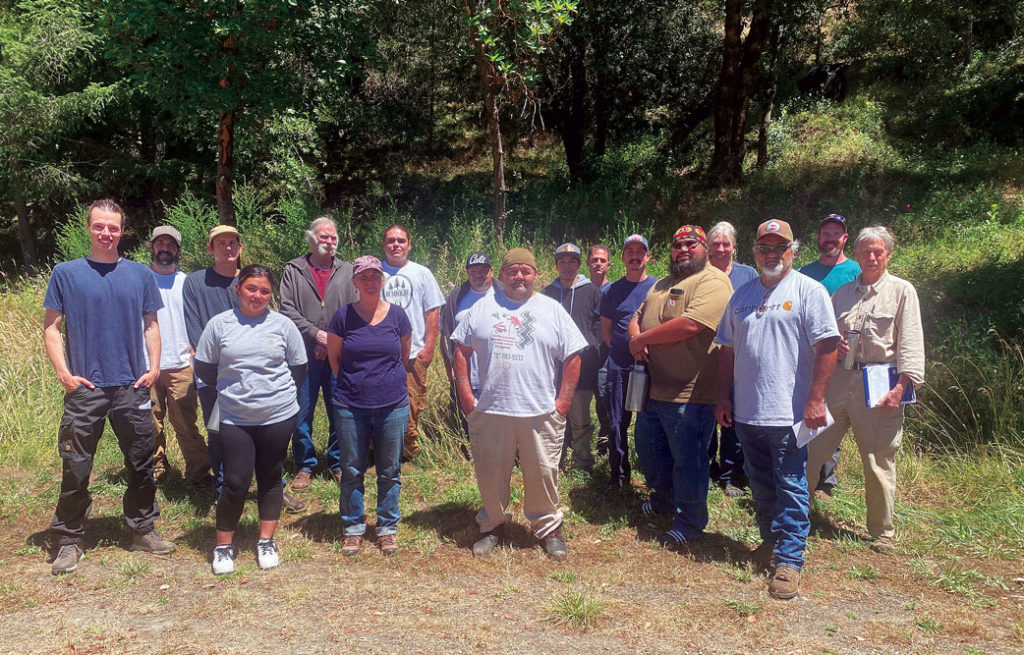
The following is a transcript of Diana Totten introducing the topic of Prescribed Fire at a training held on July 7th at the Piercy Community Center. The training was co-organized by Native Health in Native Hands, with the goal of preparing Indigenous youth to join Southern Humboldt fire crews on controlled burns. [Editor’s note: As we go to print on July 19, six Wailaki are among the crew conducting a burn in Briceland.]
Introduction
Thank you for coming. My name’s Diana Totten, I’ll be working with you today. My job will be to give you a little bit of an outline of prescribed fire; then I’ll be going over a lot of what we do in a regular fire class, which I’ve been doing for about 40 years. Teaching fire to firefighters is something I have a passion for. Switching gears and teaching fire for prescribed burning is a little bit different, so bear with me as I try to do that. Also, a component of this prescribed-burn training is going to be cultural burning.
I was raised by a Wintu grandmother. I’m pretty blonde, but that blood runs strong through my veins pretty hard and it feels good. I was born in Garberville in 1955, and I’ve been here all my life. It has changed a little bit over the years and I want to talk about that, but before we go any further—I introduced myself, let’s go around the room and find out who everyone else is.
[The room of about 20 people introduced themselves, including co-organizer Perry Lincoln of Native Health in Native Hands; co-instructor Kai Ostrow of the Southern Humboldt Prescribed Burn Association and Briceland Volunteer Fire Department; several Indigenous Wailaki and Wintu youth, a representative of the Cahto tribe, representatives of Redwood Forest Foundation and Piercy Fire District, and Volunteer firefighters from Piercy and Bell Springs.]
Fire as the Fourth Element
When I was younger in the ‘60s and ‘70s, there was a band called Earth, Wind and Fire, and that’s where I’m going start. You know, we have the Earth that we’re living on and all of our ancestors, no matter where you’re from, have lived on the Earth. Like Perry [Lincoln] said, we’ve learned, over thousands of years, to coexist with the Earth. In doing so, it provided our home, our clothing, our food, everything we needed. And through the generations, it was managed in a way that kept providing those things. And so we’ve come to a place where now, the Earth is different to most people. It still provides these things, but it’s managed in a different way. So we have the earth and we have the wind…
The wind—the air, the oxygen—we can’t really change a lot about the air. We can’t change the air temperature. We can’t change how hard the wind blows, but it’s essential for everything we do.
The water—water is the key to everything in life. For a lot of us, water comes right out of the ground and then comes through the kitchen sink, which is pretty cool. But in a lot of places, people don’t even know if they can drink the water that comes from the ground. It goes through a process to get all the germs out of it and make it to where basically there’s no life in it. And the sky has water in it, the air around us right now has water. We have a lot of water inside of us. Water is life, and that’s a key ingredient.
And then…the fourth element is fire. And if you say “fire,” all of a sudden, a lot of people are triggered. Their adrenaline glands just opened up because fire is a scary and dangerous thing. And everyone has visions of what they see in the media, whether it’s TV or the newspaper, of a catastrophic wildfire and towns are burning. I mean, the Walmart in Santa Rosa burned, how does that happen? It’s all concrete, right? So these things are happening around us now more and more and more.
And I think back to when I was young here, and I told you I was born in 1955. And so I remember [when I was] five and six years old, I remember lots of meadowland through all of Southern Humboldt, all the way to the ocean. And my grandmother would come into town every once in a while, and we’d go with her to town. And the great sport was going back out to Four Corners and she would stop so that we could count the deer in the meadows—50, 60, 70 deer in the meadows. And now, I don’t even know where the meadows are. They’re not there.
So…Whitethorn is all different, and I’m not even 70 years old yet. So step back 700 years and think about what it looked like. I drive down the freeway and I see all the trees that I’m older than. I’m older than a lot of stuff. And yet I look, and I try to take that vision back to our ancestors and what it looked like here, and…we lost the balance.
…Like was said earlier, we have landslides; we have floods; we have hurricanes and strong winds that blow things over; and we have fires that wipe out entire communities. We can’t really do too much about the floods. They’re going to happen when the rains come at the perfect time and lots of it. We can’t do much about the hurricanes, other than get on the other side of the hill so it doesn’t blow so hard. And we can’t do a whole lot about Mother Earth and the landslides and the earthquakes. But the one thing we can have an influence with, to help bring the balance back, is fire. And that’s the reason we’re here, is to start thinking more like that.
Influencing the Environment Through Fire
Think about how each day the headlines are about climate change, and we’re passing lots of laws and we’re doing lots of things. And I’m not sure that’s the perfect direction to go, but I don’t know how we change the climate. What we can change is our local environment. And if we just start small right here where we live, we could start to change that, and we could do it by prescribed fire. We could do it like our ancestors did and have more of a balance in our local communities. You start to create a mosaic. And so I live at Benbow, I have 13 acres over there. And my kids are there and it’s kind of like the rest of this area where, “Oh geez, I should go cut that. I got other things to do.”
So the kids decided to take it to the next level. They just drew a map of the 13 acres, and they take one year, one acre and they manage that to what it needs to be for fire management. Then I also started raising animals. And that started keeping down the brush. The goats eat the brush, but then we eat the goats and drink the milk. And so instead of looking at the 13 acres, we could start seeing these little tiny pieces of patchwork and then put the patches together. But it’s probably not us that’ll be doing it. It’s these people, the young people. And so if we could open that door for the young people, that’s the goal—is to pass on a little bit of what we’re thinking. And now we’re seeing what the agencies have started to see. The August Complex fire was a perfect example, guys, like, oh, that’s not what was on the program! [laughter]
[Editor’s Note: According to Wikipedia, “The August Complex was the single-largest wildfire and the largest fire complex in recorded California history. The complex originated as 38 separate fires started by lightning strikes on August 16–17, 2020. By the time it was extinguished on November 12, the August Complex fire had burned a total of 1,032,648 acres, or 1,614 square miles, about 1% of California’s 100 million acres of land.]
So for 150 years, we’ve been stopping every fire because it’s dangerous, right? And it became a way of living. And that’s what I’ve made a living doing—a big part of my life has been stopping wildfires. And it hasn’t worked.
When I was young, growing up here, a 5,000-acre fire was unheard of. We didn’t have 5,000-acre fires. I can remember just outside of Garberville, going up Alderpoint road, there was a cattle guard right by the CAL FIRE station. From there, all the way to Trinity County, were sheep and cattle. And in the summertime, the grass along the road was this high [indicates a few inches with hand]. I went up there yesterday, it’s this high [showing several feet high with hand]. Something has totally changed. And this is invasive grass. It’s not native. And so…how do we fix that? If a fire starts up there now it’s going to be very big and it will be hot all of a sudden. We stayed out of the timberlands and yet we watched the timberland get nuked. And in some places the August Complex burned so hot it burned everything into the ground.
And this is something that culturally our people were able to see that it’s not just the trees that burn, or the grass—it’s the nutrients that are underneath the top of the soil. And when that burns, it gets too hot. Then it can’t support any life for a while. And how many of you remember seeing a fire along the road somewhere and you see a big patch then in the middle of August, it burns four or five acres. Two weeks later, you drive by and there’s little green shoots coming up. It didn’t rain, nothing happened. So you see automatically stuff starts to regrow. And when that happens, that’s kind of like the cultural burning thing, it’s more than just taking the fuels out. It renews what’s underneath. But if you burn it too hot, it kills those little things. So in prescribed fire, we learned to burn a cold fire and a slow fire instead of too hot.”
Lessons from Fighting the August Complex
At the July 7th prescribed-burn workshop, Diana went on to describe her work on the August Complex and how it highlighted the ways the landscape is out of balance. It was lost on this audio recording, but later she explained it in an email:
I was a Division Supervisor on the August Complex with the job of trying to stop the fire before it crossed the Eel River. I worked from the Lake Mountain Road, all around what is known as the Lone Pine Ranch and Stewart Ranch to the town of Kettenpom. That is a big country. And at the time we had very few resources due to the size of this fire and others in the state. These were, at one time, ancestral lands and they were quite populated when the first White settlers came into the area. In fact one of the reasons the White man came there was to kill the deer for their hides. There were thousands of deer. The land was, and still is, a lot of oak woodland. I believe it burned regularly either by lightning or by cultural burning. The deer hides were dried and taken to Red Bluff to a tannery where they made leather goods for the gold miners. Thousands of deer were killed. Most were skinned just for the hide, and the meat was eaten by predators or birds.
The success of keeping the August Complex from crossing the river wasn’t all about the fire-fighting effort. As I discussed in a simple way earlier, the elements have something to do with everything. At the time the fire roared out of the Yolla Bollys (“Yolla Bolly” is a Wintu word meaning “snowy peak”), thousands of acres of old-growth forest burned with intense heat. Then it got to the Lone Pine ranch and got into the grassland and rangeland. Hundreds of head of cattle had eaten the grass so it was pretty short. The winds slowed a bit. Once the fire intensity decreased, we were able to start making progress on containment of the front of the fire. We used old roads and created fire lines with dozers and hand tools. And yes, we backfired some areas which helped to stop the fire.
So looking back, there is a combination of things that stopped the fire. Fuel type changed, wind slowed down, and we took advantage of this. We need to start somewhere. Standing in front of a million acre wildfire and using the land and fuels, the weather, and a few trained firefighters to help slow it and eventually to stop it is a humbling experience. How about we start with an acre at a time.
Building Traditional Redwood Canoes for the Eel River
A Historic Collaboration with California State Parks and Local Tribes
The ancient cultural tradition of redwood canoe crafting was nearly lost for the Wailaki and Wiyot tribes, but it is being revived thanks to a collaboration between Native Health in Native Hands and California State Parks. State Parks provided a redwood log for a Wiyot canoe and a Wailaki canoe. Volunteers from each tribe have been crafting them at Richardson Grove State Parkon weekends from the start of June until July 16th, when the canoes were loaded and moved to Wiyot land.
The following is a partial transcript of Wailaki and Wintu participant John Elgin speaking with Tonya Horlik in June. The full interview aired on KMUD’s Local Public Affairs program on June 30 and can be heard at http://tinyurl.com/redwoodcanoes.
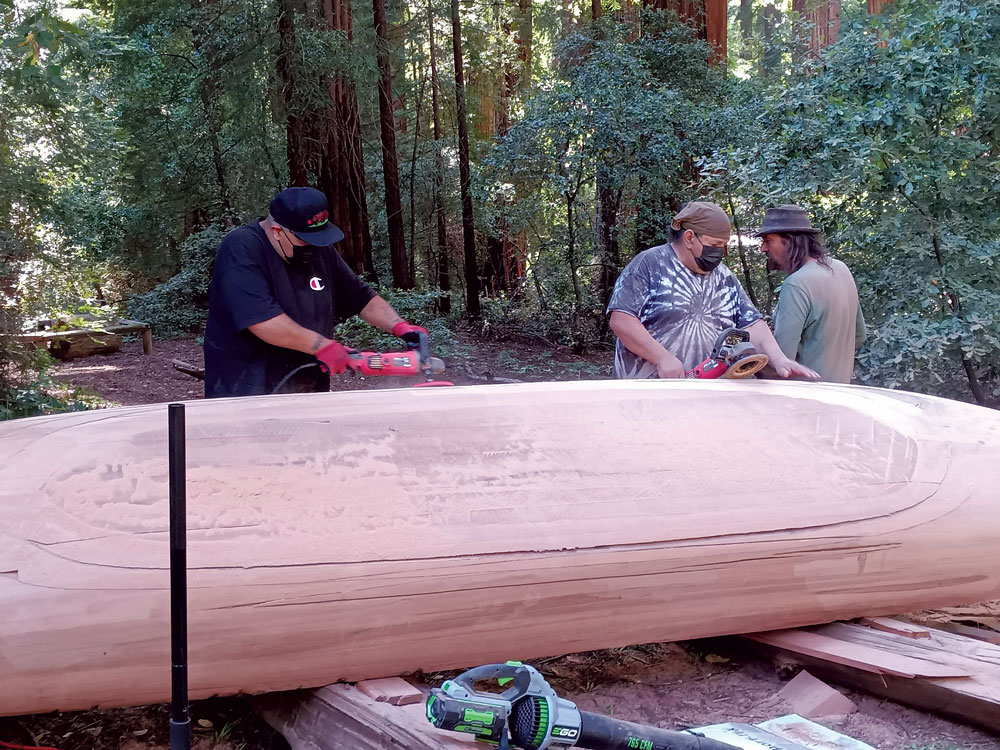
Photo by Kerry Reynolds
John Elgin: Perry Lincoln, he got this organized with the State [Parks], and this is the first time in 100 years that this has been done, where they are allowing the Native Americans to come into the old growth to be able to do our traditional practices. They actually got the wood for us.
With the groups that are here, a lot of people don’t realize that they were actually used to eradicate each other. We’ve got over 100 years of turmoil, even though a lot of people think that this was just an overcoming between the tribes and the state—this is an overcoming of even the tribes against the tribes…They were used to hunt each other throughout the time period that the White people utilized them to eradicate each other. So for years, it was also a heavy turmoil between the tribal groups. They wouldn’t even be seen on the same small spot.
So when this all came together, we invited everybody. There’s been a lot of prayers and a lot of education through being able to have lunch with some of these people. Through conversation, come to find out that, through some of the original Native Americans who were full bloods who stood in line and got their number at the beginning of the reservations, most of the guys here are technically related. We’re second, third, fourth cousins, five times removed. We’ve got the same original full-blood ancestry. Without this [canoe project], none of that would have even been known. It came out in conversation. Without the peacefulness of these canoes and the interaction with the State [Park], the healing between the people wouldn’t have happened.
Preparing to Craft Traditional Redwood Canoes
So now we start here with prayer. We start with asking for forgiveness within our own hearts, and then we go to work. So that, when we’re standing at our canoe, we don’t want to bring any bitterness into that wood. It’s kind of like the basket weavers. They say a prayer with every woven knot, and they have to be within forgiveness, so that not one of those knots in the basket has remorse or animosity, so that they can give it away with a good heart.
We’re very similar to this. We start our day with a prayer of forgiveness and blessing for everybody that comes, as well as the ones that are here and who are all in different stages. In another month we’re probably going to take these up and go someplace else, because Bob, the original Yurok educator, his time is limited before he has to go do other things. He’s gonna get us all laid out in the basic designs of it all, and we’ll end up finishing it. But once these are all done, we’re going to qualify to go into the rivers.
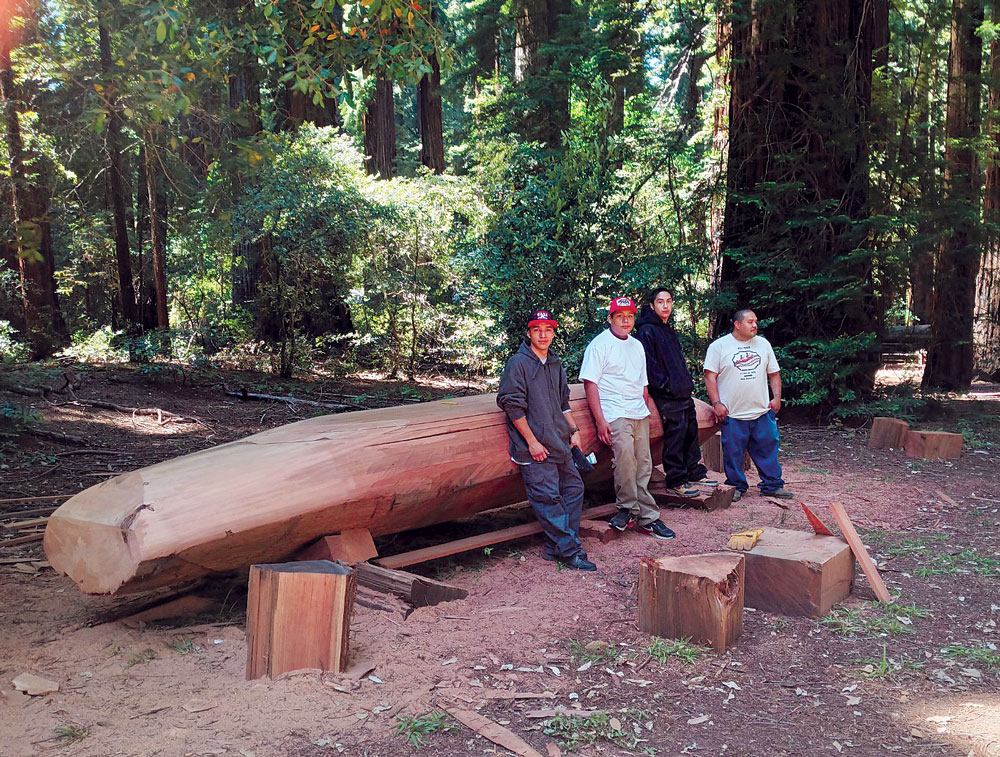
Preparing the Redwood Canoes for the Ocean and Rivers
We will go basically from Fort Bragg, north. We’ll be able to interact with the streams as well as the oceans and the animals that are there, so that we can identify what needs help, what needs interaction, and do what we’ve done for thousands of years. This has basically been the beginning of not just, like I said, us working with the State [Park], but us working with each other. We’re going to have a canoe race where there’s at least eight of these canoes and we’re going to have a yearly invitational where we race down the river, that’s something else.That’s never been done, except for pre-white incursion.
We’ve got a lot of things planned that are social interaction for children, both for our own tribes and bringing more tribes together. We’re going to be able to do this all the way to Washington in the Nisqually, where they have thousands of canoes and where we’ve got cousins up there. This is the beginning of something that is more than just a canoe, it’s also going to be a healing of a community within the hierarchies of the tribes. For example, the Wiyot, their board members are here doing this. It’s just not a small group of people on the side. It’s actually board members.
John Elgin: We’ve been doing this for about two months so far, and it started in a whole other log yard. We started splitting them and making them smaller, then we haul them here. And now we come down on the weekends, and we’re open to all Native American families. And this is what’s called a dry camp. Even if someone spends the night, there’s no alcohol, no drugs. It’s a camp where children get to come and learn. It’s a place where the children get to speak and help us laugh and be human and interact in the same way our elders used to interact before the sadness came into our lives. And so even during lunch, we throw grapes at each other and we have fun and we laugh and we tell jokes. And this has been a really good healing thing for the whole Native American community.
Celebrating the Redwood Canoes as they Leave Richardson Grove
On July 16, dozens gathered to mark the occasion of the redwood canoes departing Richardson State Park in order to be completed further north on Wiyot land. KMUD News Director Lauren Schmitt interviewed several people there for a KMUD News special that can be found at www.kmud.org.
The following is a portion of her interview with Erin Gates, Deputy District Superintendent for California State Park’s North Coast Redwood District. The interview is edited for space and clarity.
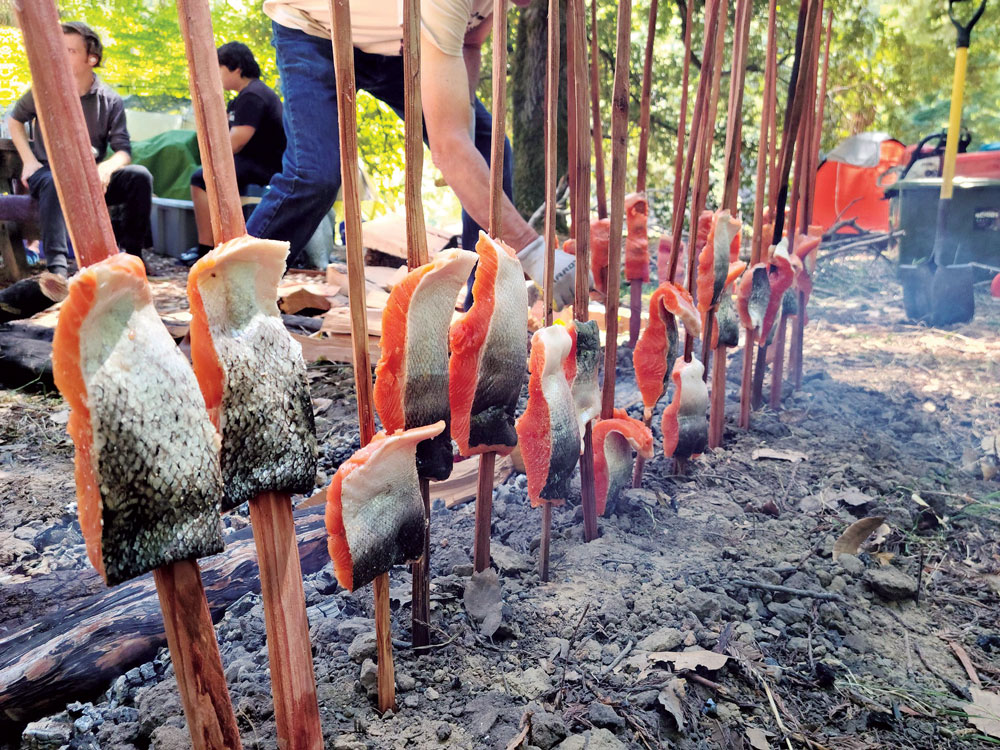
Erin Gates: I work under Victor Bjelajac, helping to support his efforts in managing over 22 State Parks across three counties. I also work directly with Redwood National and State Park Superintendent Steve Mietz.
This is an incredible honor and an opportunity to have ancestral lands be used for cultural practices again after decades of that not happening, in part because we didn’t make space for that to happen. To know that we are forming healthy relationships with our tribal communities, and that they have trust in us to want to practice their cultural practices on State Park lands, this is one of the most meaningful experiences that we have had a chance to have. I’m speaking on behalf of myself and Victor Bjelajac.
These are their ancestral lands that they’ve been protecting for millennia, and we’ve only been protecting them for the last 100 years. In order to best protect these amazing places, [we need] to go back to the Traditional Ecological Knowledge of the people that have been here for millennia. We also need to have healthy relationships established so that they can come to parks and feel welcome to practice their cultural traditions that they have been practicing since time immemorial.
For more information: Facebook.com/NativeHealthNativeHands
